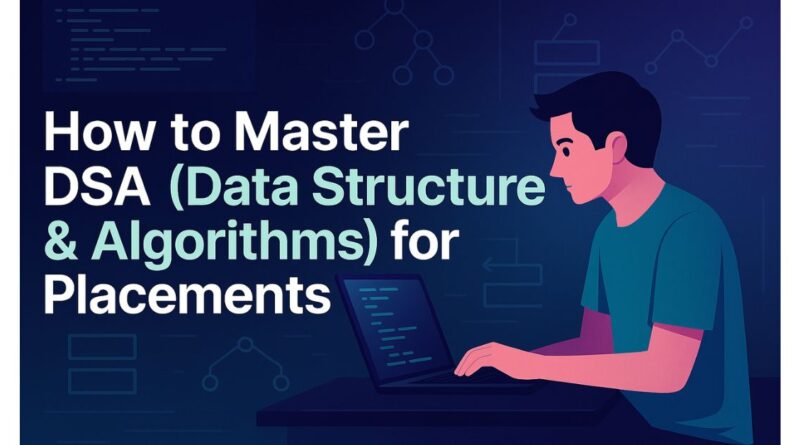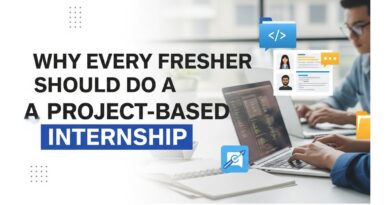How to Master DSA (Data Structures & Algorithms) for Placements
How to Master DSA (Data Structures & Algorithms) for Placements
In today’s hyper-competitive tech landscape, Data Structures and Algorithms (DSA) is more than a topic you learn in college—it’s the cornerstone of your placement journey.
Whether you’re preparing for startups or tech giants like Google, Amazon, Microsoft, or Meta (FAANG), one thing remains consistent: DSA dominates the coding interviews.
If you’re a fresher asking, “How do I master DSA from scratch?”—this is your complete roadmap. From learning the very basics to tracking your progress and acing mock interviews, we’ll walk you through everything you need to become DSA-proficient and placement-ready.
📌 Section 1: Why DSA Is Essential for Placements
🔍 Why Do Companies Focus So Much on DSA?
Understanding this is the first step to take your prep seriously.
-
Evaluates real-world problem-solving: DSA forces you to think in steps, just like real engineering problems. Can you build a scalable system? Can you optimize for speed and memory?
-
Language-agnostic skill: Whether you’re comfortable in Python, Java, C++, or JavaScript, DSA is the same at its core.
-
Objective screening: In a pool of thousands, it helps companies fairly and quickly identify the best problem-solvers.
-
Standardized skill filter: Unlike resumes that can be fluffed up, coding problems reveal your true abilities.
💡 What Skills You Demonstrate When You Know DSA:
-
Logical and analytical reasoning
-
Ability to break down and simplify complex problems
-
Optimization under tight constraints
-
Clean, modular, and readable coding
-
Edge case awareness (null input, zero size arrays, large inputs, etc.)
🧱 Section 2: Learn DSA from Scratch — The Right Way
Let’s break the myth that you need to be a coding genius to learn DSA. The truth is, with a structured approach and consistent practice, anyone can master it.
🚀 Step-by-Step Kickoff for Beginners:
-
Choose a programming language:
-
Python: Clean syntax, easy to debug, beginner-friendly
-
C++: Great STL support, favored in competitive programming
-
Java: Object-oriented, verbose but widely accepted
-
-
Master language fundamentals:
-
Loops (
for,while) -
Conditions (
if-else) -
Arrays, strings
-
Functions and recursion
-
-
Start solving simple problems:
-
Use HackerRank, LeetCode, or CodeStudio
-
Focus on problems involving arrays, strings, sorting, and basic math
-
🧠 Pro Tip:
Don’t rush into solving “hard” problems on Day 1. Instead, build a mental muscle for problem-solving by solving easy ones first. Confidence compounds over time.
🗺 Section 3: The Ultimate DSA Roadmap for Beginners
A roadmap simplifies the journey. Here’s a phased plan designed to cover all essential topics, starting from zero.
📘 Phase 1: Foundation Topics (Weeks 1–2)
-
Arrays: Rotations, duplicates, sliding window
-
Strings: Anagram checks, palindrome detection, string reversal
-
Sorting: Bubble Sort, Insertion Sort, Merge Sort, Quick Sort
Focus on brute-force approaches first, then optimize. Track time and space complexity.
📗 Phase 2: Linear Data Structures (Weeks 3–4)
-
Linked Lists:
-
Singly and Doubly Linked Lists
-
Reversals, detection of cycles (Floyd’s Cycle), merging
-
-
Stacks:
-
Valid parentheses, next greater element, infix-postfix conversion
-
-
Queues:
-
Circular queue, LRU Cache basics
-
-
HashMaps/Sets:
-
Frequency counting, two-sum problem, union/intersection of arrays
-
📙 Phase 3: Non-linear Structures (Weeks 5–6)
-
Trees:
-
Binary Tree, BST, Tree Traversals (Inorder, Preorder, Postorder)
-
Lowest Common Ancestor (LCA), Height of tree
-
-
Heaps:
-
MinHeap/MaxHeap creation
-
Top-K frequent elements, HeapSort
-
-
Graphs:
-
Representation (Adjacency List/Matrix)
-
DFS, BFS, Cycle Detection
-
Topological Sorting, Dijkstra’s Algorithm
-
📕 Phase 4: Advanced Concepts (Weeks 7–8)
-
Recursion:
-
Factorial, Fibonacci, permutations
-
-
Backtracking:
-
N-Queens, Sudoku Solver, Maze Problems
-
-
Dynamic Programming:
-
0/1 Knapsack, Longest Increasing Subsequence, Matrix Path
-
-
Greedy Algorithms:
-
Activity Selection, Huffman Coding, Fractional Knapsack
-
🎯 Section 4: Best Platforms to Learn and Practice DSA
👶 Beginners:
-
HackerRank – Friendly UI, categorized challenges
-
GeeksforGeeks – Problem + explanation combo
-
CodeStudio (by Coding Ninjas) – Great guided roadmaps
🧑💼 Interview Focused:
-
LeetCode – Real questions from Google, Meta, Amazon
-
InterviewBit – Gamified interview prep
-
Coding Ninjas – Paid mentor-led DSA courses
⚔️ Competitive Coders:
-
Codeforces – Weekly rated contests
-
CodeChef – Monthly long challenges
-
AtCoder – Advanced algorithm-heavy problems
Start with HackerRank + LeetCode and transition to Codeforces as your confidence grows.
🧠 Section 5: Key Problem-Solving Patterns
Smart DSA prep isn’t about grinding thousands of problems randomly. It’s about understanding core patterns.
🔑 Must-Know Patterns:
-
Sliding Window:
-
Used in subarray problems (e.g., max sum subarray of size K)
-
-
Two Pointers:
-
For sorted arrays, removing duplicates, palindromes
-
-
Binary Search:
-
Search rotated arrays, min/max problems (binary search on answers)
-
-
Recursion + Memoization:
-
Fibonacci, DP-based solutions
-
-
Greedy Strategy:
-
Interval scheduling, coin change (Greedy version)
-
-
Backtracking:
-
Subsets, permutations, constraint-satisfaction problems
-
-
Topological Sort:
-
Dependency resolution, course scheduling
-
📅 Section 6: Weekly DSA Practice Plan (4 Weeks)
Here’s a realistic DSA study plan to go from beginner to intermediate:
Week
1:
-
Learn: Arrays, strings, sorting
-
Practice: 5–7 problems daily on LeetCode or HackerRank
-
Target: 25 problems
-
Focus: Understand time complexity, dry run code
2:
-
Learn: Hashing, recursion, sliding window
-
Practice: 15–20 problems
-
Deep-dive: Time/space tradeoffs
-
Analyze: Each wrong submission (maintain error log)
3:
-
Learn: Linked Lists, Stacks, Queues
-
Practice: 5–7 problems per structure
-
Bonus: Solve 1 medium-level tree problem
4:
-
Learn: Trees, heaps, graphs
-
Practice: 20+ medium-level problems
-
End week with: A mock interview (with friend or online)
🧑💼 Section 7: What Interviewers Expect in DSA Rounds
Solving a problem correctly is just part of the equation. In most technical interviews, how you think, communicate, and approach problems is just as important as arriving at the correct answer. Interviewers want to know not just if you can solve a problem, but how you solve it.
🎤 Skills That Impress:
🧠 1. Explain Before You Code
Rather than jumping into writing code immediately, walk through your logic out loud. Explain the approach you plan to take, why it makes sense, and any potential alternatives. This shows the interviewer that you have a structured thought process.
Example: “To solve this problem, I’ll use a sliding window approach because it involves a continuous subarray. First, I’ll initialize two pointers…”
⏱ 2. Analyze Time and Space Complexity
Once you’ve proposed a solution, be sure to evaluate it:
- What’s the time complexity in Big-O notation?
- Can it be improved?
- What’s the trade-off in terms of memory?
Interviewers expect this analysis as it shows you’re thinking about scalability.
🔍 3. Test for Edge Cases
Strong candidates always consider edge cases:
- What if the input array is empty?
- What if all elements are the same?
- What if there are duplicates?
Write test cases or at least mention them out loud during the interview.
🧼 4. Write Clean and Modular Code
- Use meaningful variable names.
- Avoid hard-coded values.
- Use helper functions to keep code modular.
This makes your code easy to read and debug, which is highly valued in real-world engineering.
🚀 5. Optimization Mindset
Even if your first solution is brute-force, that’s okay—what matters is that you improve it iteratively:
“I’ll start with a naive O(n^2) solution and then optimize it using hashing to bring it down to O(n).”
❗ Bonus: Communicate While Stuck
Everyone gets stuck during interviews. The worst thing you can do is go silent. Instead:
- Share what you do understand.
- Ask clarifying questions.
- Reframe the problem aloud.
Interviewers appreciate candidates who communicate under pressure.
🧮 Section 8: Data Structures You Should Master (Explained In-Depth)
Mastering DSA is not just about solving problems—it’s about understanding when and why to use specific data structures. Each data structure comes with strengths, weaknesses, and use-cases that show up frequently in interviews and real-world engineering.
Let’s break down each essential data structure, how it works, where it shines, and what kind of problems it helps solve.
📦 1. Arrays and Strings
What it is:
An array is a fixed-size collection of elements stored in contiguous memory locations. Strings are essentially arrays of characters.
Why it’s important:
Arrays are the foundation of programming and appear in almost every DSA topic—from sorting and searching to dynamic programming. Strings are ubiquitous in real-world applications like input validation, text processing, and parsing.
Key Operations:
-
Indexing: O(1)
-
Traversing: O(n)
-
Insertion/Deletion: O(n) (unless at the end)
Common Interview Problems:
-
Maximum subarray sum (Kadane’s Algorithm)
-
Two Sum problem
-
Rotate array
-
Longest common prefix (strings)
-
Palindrome check
Real-World Uses:
-
Image pixel representation
-
Audio waveform data
-
Character encoding in text editors
Tip:
Mastering arrays means you’re equipped to learn most other data structures easily. Every DSA journey begins here.
🔗 2. Linked Lists
What it is:
A linear data structure where each element (node) contains a value and a pointer to the next (and possibly previous) node. Variants include:
-
Singly Linked List
-
Doubly Linked List
-
Circular Linked List
Why it’s important:
Unlike arrays, linked lists provide dynamic memory allocation and efficient insertion/deletion at arbitrary positions.
Key Operations:
-
Insertion/Deletion at head or tail: O(1)
-
Searching: O(n)
Common Interview Problems:
-
Reverse a linked list
-
Detect cycle in a list (Floyd’s Cycle Detection)
-
Merge two sorted lists
-
Find the middle node
-
Remove N-th node from end
Real-World Uses:
-
Memory management in OS
-
Implementation of queues and stacks
-
Web browser navigation (back/forward)
Tip:
Know how to implement from scratch. Interviewers love asking pointer manipulation problems.
🗂 3. Stacks and Queues
What it is:
-
Stack: Last In, First Out (LIFO)
-
Queue: First In, First Out (FIFO)
Both are linear data structures used for controlling data flow.
Why it’s important:
They solve real-time process problems like undo-redo functionality, expression evaluation, task scheduling, and more.
Key Operations:
-
Push/Pop (Stack): O(1)
-
Enqueue/Dequeue (Queue): O(1)
Common Interview Problems:
-
Valid parentheses
-
Evaluate postfix/infix expression
-
Implement Stack using Queues and vice versa
-
Next greater element
-
Sliding window maximum (Monotonic Queue)
Real-World Uses:
-
Browser history (Stack)
-
Call stack in recursion
-
CPU scheduling (Queue)
-
Print job management
Tip:
Master their array-based and linked-list-based implementations. Many coding rounds test your ability to implement a stack or queue from scratch.
⚡ 4. HashMaps and HashSets
What it is:
A HashMap stores key-value pairs for quick access, while a HashSet stores unique elements.
Why it’s important:
They provide average-case O(1) time complexity for insertions, deletions, and lookups. Perfect for frequency counting, caching, and duplicate detection.
Key Operations:
-
Insert/Delete/Lookup: O(1) (average), O(n) (worst-case with collisions)
Common Interview Problems:
-
Two Sum
-
Group Anagrams
-
Longest substring without repeating characters
-
Detect duplicates
-
Frequency analysis
Real-World Uses:
-
Implementing databases
-
Caching using LRU
-
URL mapping
-
Lookup tables
Tip:
Know the underlying hashing mechanism and how collision handling (like chaining and open addressing) works.
🌲 5. Trees and Binary Search Trees (BST)
What it is:
A Tree is a non-linear, hierarchical data structure. A Binary Tree has at most two children per node. A Binary Search Tree (BST) is a binary tree where left child < root < right child.
Why it’s important:
Used in hierarchical data, fast searching, and sorted data operations. Interviewers test tree traversal depth, recursion, and understanding of invariants.
Key Operations:
-
Search (BST): O(log n) average, O(n) worst
-
Insert/Delete: O(log n) average (balanced BST), O(n) worst
Common Interview Problems:
-
Inorder/Preorder/Postorder traversal
-
Level order traversal (BFS)
-
Height and diameter of a tree
-
Lowest Common Ancestor (LCA)
-
Validate BST
-
Serialize and Deserialize binary tree
Real-World Uses:
-
Database indexing (e.g., B-Trees)
-
Filesystem hierarchy
-
DOM in web development
Tip:
Practice writing recursive and iterative versions of tree traversals. These are common in interviews.
🧮 6. Heaps (Min/Max Priority Queues)
What it is:
A complete binary tree that satisfies the heap property.
-
Min Heap: Parent ≤ Children
-
Max Heap: Parent ≥ Children
Usually implemented as arrays for efficiency.
Why it’s important:
Heaps are great for priority-based tasks, finding K-th largest/smallest elements, and implementing priority queues.
Key Operations:
-
Insert: O(log n)
-
Remove Min/Max: O(log n)
-
Peek Min/Max: O(1)
Common Interview Problems:
-
Kth largest element in array
-
Merge K sorted lists
-
Top K frequent elements
-
Median in a stream
-
HeapSort
Real-World Uses:
-
Task scheduling
-
A* pathfinding algorithm
-
Bandwidth management (priority data transmission)
-
Load balancing
Tip:
Understand how a heap is built using arrays and how to use a custom comparator.
🌐 7. Graphs
What it is:
Graphs consist of nodes (vertices) connected by edges. They can be:
-
Directed or undirected
-
Weighted or unweighted
-
Cyclic or acyclic
Why it’s important:
Graphs represent real-world networks: roads, social networks, website links, etc. They are used in route optimization, dependency resolution, and data relationships.
Key Operations:
-
Traversals (DFS, BFS): O(V + E)
-
Path finding: Dijkstra, Bellman-Ford, Floyd-Warshall
-
Cycle detection: O(V + E)
Common Interview Problems:
-
Number of islands
-
Clone a graph
-
Detect cycle in directed/undirected graph
-
Topological sort
-
Shortest path in maze
Real-World Uses:
-
Google Maps (routing)
-
Social media connections
-
Package managers (dependency resolution)
-
Network packet routing
Tip:
Master adjacency list/matrix representations and DFS/BFS traversal algorithms. Graph problems often blend recursion, backtracking, and data structure design.
🔠 8. Tries (Prefix Trees)
What it is:
A tree-like structure used to store a dynamic set of strings, typically for quick prefix matching.
Why it’s important:
Tries are incredibly efficient for searching words, auto-completion, and dictionary-based applications. Unlike HashMaps, they allow ordered traversal and prefix-based lookups.
Key Operations:
-
Insert word: O(L) where L = word length
-
Search word: O(L)
-
Prefix match: O(L)
Common Interview Problems:
-
Word search in a board
-
Auto-suggestions
-
Implement a dictionary
-
Longest prefix matching
Real-World Uses:
-
Search engines (Google autocomplete)
-
IP routing (longest prefix match)
-
Spell-checkers
-
T9 predictive text input
Tip:
Learn to implement a basic Trie from scratch and understand how it differs from maps and arrays in terms of performance and traversal.
🔚 Summary Table – Cheat Sheet
| Data Structure | Operations (Best Case) | Common Problems | Real-World Use |
|---|---|---|---|
| Arrays & Strings | Index: O(1) | Subarray sum, Anagrams | Image data, text |
| Linked Lists | Insert: O(1) at head | Reverse list, Cycle detect | Memory mgmt |
| Stack | Push/Pop: O(1) | Valid parentheses | Call stacks |
| Queue | Enqueue/Dequeue: O(1) | BFS traversal | Print queues |
| HashMap | Lookup: O(1) avg | Two Sum, Frequency count | Caching |
| Trees/BST | Search: O(log n) | Tree traversals, LCA | DB indexing |
| Heap | Insert/Extract: O(log n) | Top K, Stream median | Load balancer |
| Graph | Traversal: O(V + E) | DFS, BFS, Path finding | Networking |
| Trie | Search: O(L) | Prefix matching | Autocomplete |
🔍 Final Thoughts
Knowing data structures is not just about definitions—it’s about:
-
Understanding how they behave under different scenarios
-
Picking the right structure for the problem
-
Optimizing based on space and time constraints
Interviewers will test not only your coding ability but your decision-making process—why you chose a stack over a queue, or a trie over a hashmap.
💡 Pro Tip:
Whenever you learn a new data structure, build it yourself. Write the insert, delete, and search methods from scratch. Understanding comes from construction, not just usage.
📚 Section 9: Resources to Learn and Revise DSA (Expanded)
Learning DSA requires a blend of theory, practice, and structured revision. While solving problems on coding platforms is essential, having the right learning materials and references helps reinforce concepts and tackle tricky problems with confidence. Here’s a breakdown of the best YouTube channels and books to support your DSA journey.
🎥 YouTube Channels
🎯 Take U Forward (Striver)
Striver’s “Take U Forward” is one of the most popular and trusted channels for mastering DSA. His A2Z DSA Roadmap is a step-by-step guide covering every core DSA topic with well-explained coding examples and dry runs. His explanations are clear, and he often refers to real interview questions.
-
Best For: Beginners to intermediate learners following a structured path.
-
Strength: Systematic progression from basics to advanced topics.
-
Unique Feature: Based on his famous Striver’s DSA Sheet used by thousands of students.
🧒 Apna College (Aman Dhattarwal)
A go-to channel for absolute beginners, Apna College explains DSA topics in a simple, student-friendly tone. Most content is in Hindi, which makes it even more approachable for a wide audience in India.
-
Best For: College students starting with DSA.
-
Strength: Fun and engaging teaching style, often includes life advice too.
-
Popular Series: Data Structures in Java playlist.
👨💻 Kunal Kushwaha
Known for building open-source communities, Kunal’s channel offers DSA tutorials along with guidance on GitHub, real-world development, and career planning. His roadmap is well-suited for complete beginners who want to integrate DSA with practical development skills.
-
Best For: Beginners aiming to enter tech with a community-driven learning path.
-
Strength: Strong focus on learning in public and contributing to open source.
-
Bonus: Live sessions and collaborative coding events.
💬 CodeWithHarry
A highly popular educator on YouTube, Harry’s playlists offer crash courses in C++, Java, Python, and DSA—all in Hindi. His practical approach helps bridge the gap between coding concepts and real-world usage.
-
Best For: Learners seeking fast-track understanding in Hindi.
-
Strength: Quick tutorials with real coding demonstrations.
-
Tip: Use his crash courses for revision or language-specific prep.
📘 Books
📗 Cracking the Coding Interview by Gayle Laakmann McDowell
A must-have for serious interview preparation, this book contains 189 programming questions that simulate real interviews. It doesn’t just focus on solutions but teaches you how to approach problems during an interview.
-
Ideal For: Intermediate to advanced learners targeting FAANG roles.
-
Coverage: Arrays, Linked Lists, Trees, Bit Manipulation, and more.
-
Bonus: Tips for behavioral interviews and system design basics.
📘 Elements of Programming Interviews (EPI) by Adnan Aziz
Known for its depth and difficulty, EPI is excellent for refining your problem-solving skills. The problems are designed to push your algorithmic thinking and pattern recognition.
-
Ideal For: Advanced learners looking for a challenge.
-
Features: Detailed problem classifications, solutions with code in C++, Java, and Python.
-
Great For: Practicing under interview-like conditions.
📕 Data Structures and Algorithms Made Easy by Narasimha Karumanchi
One of the most beginner-friendly books in the DSA space, this book explains foundational topics in plain language and is widely recommended for college students preparing for campus placements.
-
Ideal For: Beginners who need conceptual clarity.
-
Focus: Step-by-step solutions for classical problems.
-
Language: Examples in C/C++ with a strong Indian academic focus.
📌 Final Tips for Using These Resources Effectively
-
Mix & Match: Watch a video, then read a book chapter, then solve a problem.
-
Revise Frequently: Rewatch difficult topics and revisit book solutions regularly.
-
Apply Actively: Implement code examples by hand rather than copy-pasting.
-
Track Progress: Maintain a Notion board or spreadsheet with topics, resources used, and understanding level.
✅ Section 10: Revision and Tracking Progress
You don’t retain DSA just by solving once—you need to revisit and revise.
📝 How to Revise Smartly:
-
Maintain a DSA Journal/Notebook or Notion doc
-
Record:
-
Mistakes and corrections
-
New patterns learned
-
Edge cases and constraints
-
-
Use:
-
LeetCode streak tracker
-
GitHub repo for all solved problems
-
Flashcards for complexities (e.g., Quick Sort = O(n log n))
-
⚠️ Section 11: Common Mistakes Freshers Make
Even dedicated learners fall into these traps:
-
Jumping to dynamic programming without knowing recursion
-
Blindly copying code without understanding
-
Ignoring brute-force when asked to explain all solutions
-
Practicing only easy problems
-
Avoiding mock interviews due to fear
🔁 Fix:
-
Solve slowly, not blindly
-
Re-attempt problems you got wrong
-
Schedule at least 1 mock every 2 weeks
💼 Section 12: Using DSA in Resume and Projects
If you’ve worked hard on DSA, don’t hide it—highlight it!
🖋 What to Add in Resume:
-
LeetCode Stats: “Solved 600+ problems across arrays, DP, graphs”
-
Competitive Rankings: “CodeChef 4★”, “Top 5% in Google Kick Start”
-
GitHub Repo: With structured DSA solutions
-
Mini Projects:
-
Visualizers (Heap Tree, Sorting Algorithm Animations)
-
Implementations (Custom Linked List, Graph API)
-
🧩 Conclusion: Start Small, Stay Consistent
Mastering DSA is not about solving every problem online. It’s about:
-
Understanding logic and reasoning
-
Practicing problem-solving patterns
-
Being consistent week after week
-
Speaking confidently during interviews
You don’t need to be perfect. You just need to be prepared and persistent.
📍 Your Next Steps:
✅ Pick a language
✅ Start the 4-week plan
✅ Track your learning
✅ Schedule a mock interview
✅ Aim for understanding, not memorization
DSA mastery doesn’t happen in a week—but every day you delay, someone else gets ahead.
Open your laptop, pick a platform, and start. The tech world rewards those who prepare.
Let your DSA journey begin today.
Follow Us for more Updates: Telugu Careers Hub




